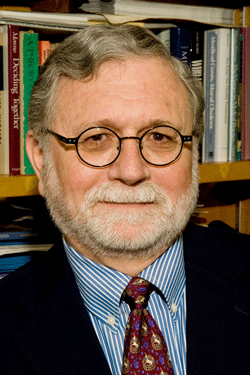CDC funds PLAY to understand ADHD prevalence in U.S.
November 13, 2012

Dr. Robert McKeown of the Arnold School
led a team of USC researchers for the
CDC report on ADHD.
University of South Carolina researchers played an integral role in one of the largest studies conducted on Attention Deficit Hyperactivity Disorder (ADHD) in the United States.
The Project to Learn about ADHD in Youth (PLAY), funded by the National Center on Birth Defects and Developmental Disabilities of the Centers of Disease Control and Prevention, was a collaborative research project with USC and the University of Oklahoma Health Sciences Center. The results of the study, conducted between 2002 - 2012, appear in the Journal of Attention Disorders.
Dr. Robert McKeown, former chair of the Arnold School of Public Health’s Department of Epidemiology and Biostatistics, led the S.C. portion of the study, which comprised researchers from the Arnold School and USC School of Medicine. “To our knowledge, this is the largest community-based epidemiologic study of ADHD to date.”
The study found that 8.7 percent of children in the community sample in South Carolina had enough symptoms to fit the ADHD diagnosis at the time of the initial assessment. The percentage was 10.6 in Oklahoma.
The report also revealed that the number of parents in the community sample who reported that their children were taking ADHD medication was 10.1 percent South Carolina and 7.4 percent in Oklahoma. Yet, of the children taking ADHD medication, only 39.5 percent in South Carolina and 28.3 percent in Oklahoma actually met the case definition of ADHD.
“Childhood ADHD is a major public health problem. Many studies rely on parent reporting of an ADHD diagnosis, which is a function of both the child’s access to care in order to be diagnosed, and the parent’s perception that there is a problem,” said McKeown, a Distinguished Professor Emeritus and the past president of the American College of Epidemiology.
“Further complicating our understanding of the prevalence of ADHD and its treatment is that the diagnosis often is made by a clinician who has little experience assessing and diagnosing mental disorders. As a result, ADHD is both under and over diagnosed,” he said.
The CDC reports that ADHD is one of the most common neurobehavioral disorders of childhood. Often first diagnosed in childhood, ADHD affects a child’s ability to do well in school and his or her ability to make and keep friends. While many children “outgrow” the disorder, ADHD can continue into adulthood, impacting the individual’s ability to work and function in society.
McKeown said the study found that many children taking ADHD medication did not meet the ADHD diagnostic criteria. “These children had more ADHD symptoms, on average, than the other comparison children. Many children meeting case criteria had not been previously identified and were not receiving medication treatment, suggesting that the condition remains underdiagnosed.”
The study was designed to follow children from elementary school through adolescence (ages 5 - 13) and investigate the short- and long-term outcomes of children with ADHD. Teachers screened 10,427 children in four school districts across the two states where the study was conducted. ADHD ratings by teacher and parent reports of diagnosis and medication treatment were used to determine whether children were high or low risk for ADHD.
Study questions focused on the prevalence and treated prevalence of ADHD in children; the existence of other health problems in children with ADHD, and the types and rates of health risk behaviors in children with ADHD. The study also looked at treatment patterns, both past and current, of children with ADHD.
“The findings of our study suggest that a fair number of children are being treated who do not meet case criteria and that there are children who do meet criteria but are not being treated,” McKeown said. “ADHD is not a snap diagnosis. It requires data from several sources and across several domains and considerable expertise to diagnose accurately and differentiate from other possible problems.”
Children and adolescents with ADHD also were found to have high rates of other disorders, including oppositional defiant disorder and conduct disorder. They also were more likely to engage in risky or impulsive behaviors, he said.
“We will follow up on these initial reports as the children age to determine what, if any, changes have occurred in the symptom patterns, as well as in the types of health risk behaviors,” McKeown said.
“We hope that this will shed light on the prevalence and the treatment of ADHD and will lead practitioners to seek consultation if they are not trained to assess, diagnose and treat ADHD,” he said. “We also hope it will lead parents and practitioners to assess all the treatment options to determine what works best for each child.”
USC researchers involved in the study included Dr. Steven Cuffe of the University of Florida College of Medicine-Jacksonville, formerly of the USC School of Medicine; Arnold School doctoral student Lorie L. Geryk; and Dr. Matteo Botai of the Karolinska Institutet in Sweden and Dr. Joseph R. Holbrook of the CDC, both formerly at the Arnold School.
Visit http://www.cdc.gov/Features/ADHDAwarenessWeek/ to learn more about the PLAY study and ADHD in the United States.
Check out www.garnethealthanista.com to read about the personal impact of ADHD in families.



_01.jpg)
_02.jpg)